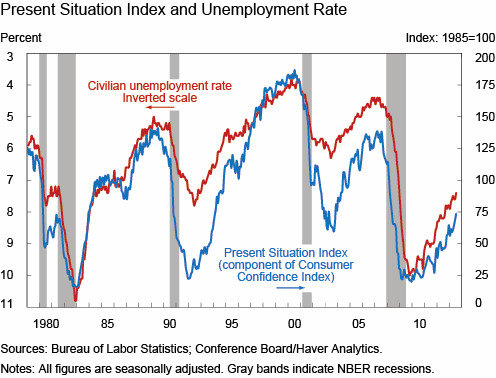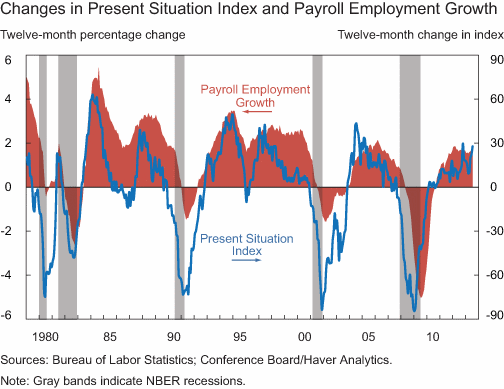A recent entry in the NY Fed's Liberty Street Economics blog makes a compelling case for the role of Consumer Confidence in forecasting labor market conditions.
Traditionally, confidence data is closely monitored because of the presumed insight it offers into future consumer spending and thus the health of the larger economy. It is widely held that the consumer's mood can independently affect the degree to which that consumer is prone to spend. Less well known is that it can also signal incipient developments in the job market. This oversight leads analysts to look at its predictive ability for consumer spending while failing to study its correlation with employment measures.
In their blog entry the authors look at trends in a particular measure of consumer confidence, the Present Situation Index component of the Conference Board's Consumer Confidence Index-over the past thirty-five years and show its close association with movements in the unemployment rate and in payroll employment.
The Conference Board measures consumer confidence based on
three questions that focus on expected changes in business conditions, job
availability, and the respondent's household income and two that focus on
present business conditions and job availability. Responses to the first three make up the
Expectations Component Index the others form the basis of the Present Situation
Index; the Consumer Confidence Index is a composite of the two. The authors' analysis suggests that the
Present Situation Index is the more useful indicator of employment.
In the following chart the Present Situation Index is plotted against the
unemployment rate. In this case the high
levels represent strong market conditions.
It is readily apparent that the two move very closely together including
through all five recessions since 1977. Less
apparent is the strong correlation (0.89) the Index has with employment two
months in the future.

The Present Situation Index is also laid against payroll job growth which is based on different data than the unemployment rate but is typically growing as unemployment declines and vice versa. Again, the close movement of the two is easily seen and again, close examination shows the Index foreshadowing movement in payrolls by a couple of months. In particular, twelve-month changes in the index are most highly correlated with twelve-month job growth four months into the future-the correlation is 0.83.

Because of the release schedule and the revision pattern of the two indicators
(consumer confidence numbers are released over a week before payroll employment
data and revised only once while employment data undergo annual benchmark
revisions) the authors suggest another way in which the comparisons could be
useful; the possibility that the confidence measure could predict revisions to
payroll employment which can occur up to a year-and-a-half after the first
estimate.
Can consumer confidence levels also predict turning points? On the chart the major turns in the Present
Situation Index tend to precede turns in the unemployment rate, particularly
going into recessions and also tend to foreshadow cyclical peaks in the
unemployment rate which often occur well after the end of a recession. It also appears able to signal sustained
downturns in payroll employment.
Whenever
it has turned negative by more than 15 points the economy has entered into a
recession, the exception being its late "prediction" of the 1982 downturn which
is often considered the second part of a double dip in the 1980 recession. It has also performed well in signaling an
incipient cyclical upturn in employment.
While it was out of sync with the last few recessions it was likely
because the early stages of those recoveries were "jobless." If one focuses on improvement in employment
rather the end of the recession then the index has always performed well.
The authors looked at the occasions
when the Index deviated from its usual relationship with the job market and
found there were discrepancies in degree.
For example, the index fell almost as low in its relationship with the
mild 1990 recession as it did with the 2008 Great Recession. This shortcoming arises from the index being
based on diffusion indexes that measure whether a given respondent thinks
things are bad, not on how bad they are.
Thus once the level reaches an exceptionally low level it can't go much
lower. The index indicated a possible
renewal of the 2001 recession in 2003 upon the invasion of Iraq but it didn't
happen. Other instances where
significant events looked as though they might trigger a recession such as the
1987 stock market crash, the Index held up well and proved the forecasters
wrong.
So why should the general public be able to predict the job market earlier than employment data? The authors say one likely reason is that many survey respondents are in the labor force, and almost everyone has close friends and relatives that work. Thus they are attuned to the general tone of the job market-at least in their region or neighborhood. They may be well aware of local business problems before layoffs begin and equally likely to know of job openings before they are filled and become part of a statistical report.







